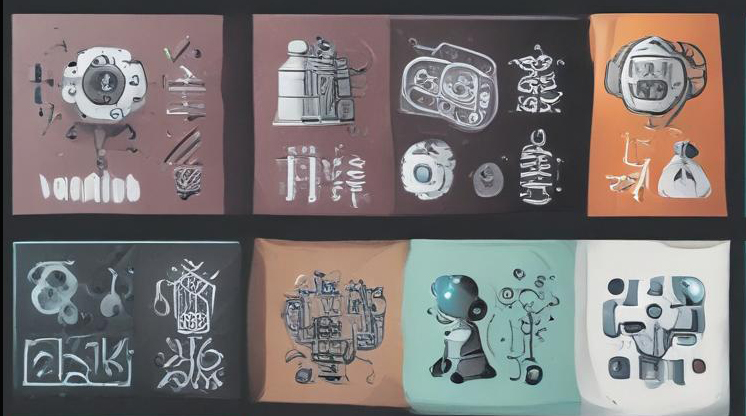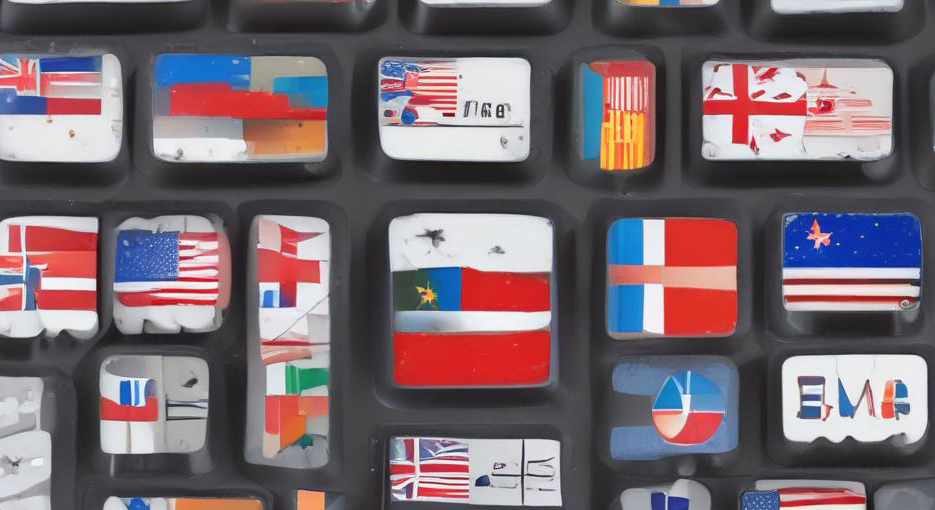Translate English videos into any language
When translating videos from popular languages such as Chinese, German, Gujarati, Hebrew, Japanese, Korean, Persian, Spanish, Tamil, Urdu, and Amharic into English, the video experiences a second wave of popularity. The reason is simple – English is rightfully considered international. It is spoken by over 1.1 billion people worldwide.
Thanks to its simplicity, English can be referred to as a 'global' language. This is supported by several facts:
Due to its simplicity, the English language is the official language in 54 countries worldwide, including many South American nations where Spanish predominates. It is spoken even in places with 2-3 other official languages. Approximately 1.6 billion people worldwide, which is 20% of the global population, communicate in English.
Explaining anything in English is not difficult because the sentence structure primarily consists of a sequence of "subject, verb, and object." This straightforward word order is easily comprehensible, as it follows a logical sequence. Therefore, even those who don't have complete proficiency in the language can grasp the essence of a video when watching it in English.
For simple videos that focus on visuals, aesthetics, and image precision, translating them into English serves as a complement to the content. But even in videos with extensive dialogues, understanding in English is often easier than attempting to grasp the essence of less familiar languages that are not international.
Considering the popularity of the English language and its ease of comprehension, it can be confidently stated that when translating videos using these methods from their "native" language to the "truly international" language, their audience can grow significantly. English is straightforward and melodious, easily perceived by the ear. Even those with only basic knowledge of English can grasp the essence of dialogues in a video that has been translated into English.
Translating from English into Chinese is unique in that the Chinese language can rapidly make the final text popular in Asian countries. It is predominantly spoken in the Republic of China, and the worldwide number of speakers has approached 1.3 billion people. Written Chinese is a true art: each character is distinct from the others. This sets this language apart from other global languages, as Chinese lacks a traditional alphabet.
If you translate a video into Chinese, you can expand your audience by millions of times. Of course, not many can dream of reaching a billion views. However, by adding Chinese as a second foreign language in your video, you can confidently grow your audience in Asian countries. Even 10 million new viewers can boost conversion rates and help you reach a new level. Chinese viewers are known for their activity: after choosing voiceovers in their language, you can enjoy a sharp increase in comments on your video and its placement in top rankings.
Translating from English into French will increase the number of views because this language is popular among residents of France and several European countries. A distinctive feature of the language is its unique pronunciation. The French speak in a manner unfamiliar to most representatives of other countries: at a high speed, which sometimes leads to the "absorption" of vowel sounds during conversation.
France is often associated with romance for a reason. This language is considered one of the most widely spoken in the EU. That's why many translate videos from English into French to significantly boost their popularity among European viewers. They can be found not only in France itself but also in Canada, Belgium, and even beyond the European Union.
Translating from English into German will make the information accessible to residents of many European countries because the German language is spoken not only in Germany itself but also in neighboring countries close to the Federal Republic of Germany, such as Liechtenstein, Austria, Belgium, Luxembourg, and Switzerland. Considering that these mentioned EU countries have developed economies, German is highly popular and is considered the most widely spoken language in the EU.
After World War II, the German language was as in-demand worldwide as English is today. Even now, decades after the end of WWII, approximately 95 million people worldwide speak German. They are likely to find it interesting to watch videos in German, a language well-known for its distinct pronunciation.
Translating from English into Italian allows the 65 million speakers of this foreign language to grasp the meaning "first-hand." The language is most popular in Italy itself, where it is considered the primary national language, as well as in San Marino, Switzerland, the Vatican, and some regions of Croatia and Slovenia. Italian is also popular among fashion enthusiasts, as Milan is considered the home of art and hosts numerous boutiques, exhibitions, and fashion designer collections.
For those who promote video content related to fashion, style, or create videos about Italy and its culture, translating the video into Italian is a must. This also applies to creators of stories about opera and football, one of the most popular sports in Italy.
Translating from English to Spanish will significantly increase the popularity of the content among Spanish-speaking speakers.
Native Spaniards speak very loudly and are known for their emotional expressiveness. Almost 550 million people worldwide speak their language. Given these numbers, Spanish is officially recognized as the "second English" and is used as an international language among residents of Latin American countries.
If you translate the video into Spanish, you can quickly promote it among millions of fans worldwide. The Spanish language is most widespread in Latin American countries, and there are several dozen of its dialects worldwide. There are more than 20 diasporas, and representatives of each will be able to appreciate the video in their native language, quickly pushing it to the top of Latin channels.
Translating from English into Korean will enhance the recognition of the material among speakers of this group of dialects. Korean is spoken by residents of two peninsula states that share many similarities but also have ongoing conflicts. The difference in mentality is reflected in the diversity of Korean dialects, which number in the dozens.
Due to the unique challenges of translating into Korean, there are not as many professional translators in the world who can quickly translate videos from English. Thanks to refined machine translation, it is possible to rapidly provide voiceovers for videos that will be understood by the Asian audience of the Korean peninsula, which comprises 78 million speakers. Even if only 10% of them watch the video, it will make it popular and increase the channel's reach.
Translating from English into Japanese will increase the number of viewers for videos among those who can understand the residents of the Land of the Rising Sun. The Japanese language is complex but beautiful and melodious. In Japanese, verbs are not conjugated because the language lacks grammatical features like plural forms and gender for this part of speech.
There are over 140 million people worldwide who communicate in Japanese. The Japanese people are known for their passion for technology, cleanliness, responsibility, and their activity on the internet.
Videos in Japanese will bring more views to the video and a sea of new subscribers to the channel. If the translated content is also helpful, grateful Japanese viewers will write many comments and significantly boost the blog's engagement, regardless of the video's topic.
Translating from English to Polish will make the text or video more popular: approximately 40 million people worldwide can watch it in its original language. This is the estimated number of Polish speakers at present, with the majority residing in Poland itself, as well as in Ukraine, Bosnia and Herzegovina, Slovakia, and the Czech Republic. Most Polish speakers are descendants of the former USSR and are native Poles.
Polish expatriates form tight-knit communities in many cities around the world. Therefore, translating a video into Polish will allow it to gain popularity among speakers of this language. Even if only 10% of Polish-speaking viewers see the video, it will become a top-performer, attracting new subscribers and dozens of comments.
Translating from English to Russian will make the video more popular among residents of the CIS countries and the former USSR. Worldwide, there are over 155 million Russian language speakers. The number of those residing in the former Soviet Union countries, where Russian is considered the second official language, is close to 110 million people.
There aren't many Russian speakers in the rest of the world, but due to its rich culture, it is sought after for study in China and English-speaking countries. For those promoting their videos about Russian culture and art, translating from English to Russian is worthwhile, as it allows fans of this language to learn a lot of new information. Thanks to Russian being the second official language among residents of the former USSR, a video in Russian will quickly become more popular among Russian-speaking viewers.
Translating from English to Ukrainian will make informational material accessible to speakers from Ukraine and the CIS, former Soviet countries where this language is in demand. The melodious Ukrainian language is spoken throughout the territory of Ukraine, as well as in neighboring states in Southeastern Europe. Ukrainian language diasporas are quite widespread in the world, and many Ukrainians strive to speak their native language, preserving its beauty and unique atmosphere.
Videos in Ukrainian will be popular among speakers who can appreciate the character of the video without the need to consult an English dictionary to understand individual phrases. There are at least 32 million Ukrainian speakers in the world, and there are also around 10 million speakers for whom Ukrainian is a secondary language.
Translating from English to Turkish will make the content popular not only among fans of vibrant Turkish series. This language is relatively straightforward in pronunciation because, in 88% of cases, Turkish words are short and uncomplicated. This largely explains why the Turkish language is in demand, with approximately 90 million people speaking it worldwide.
Most speakers are in Turkey itself, but there are also many Turkish expatriates in Belgium, France, Bulgaria, North Macedonia, Cyprus, and Greece. If the video is in Turkish, speakers of this language will be able to watch it in its original form. This will surely expand the audience of regular viewers, especially if video content is consistently translated into Turkish.






An artificial intelligence-based service for fast and accurate translation video
Translating video content from English into various foreign languages, such as Arabic, Bengali, Malay, Portuguese, and other languages spoken by hundreds of millions of users, contributes to the promotion of videos. Through translation into foreign languages, films and various videos reach a global audience, becoming accessible to a wide viewership and gaining mega-popularity.


Languages with around 100 million speakers
These are in-demand languages predominantly used in densely populated countries, such as India. Among such languages are:
• Marathi
• Telugu
• Tamil
• Vietnamese
In Marathi, approximately 83 million people converse. It is predominantly spoken in the Indian state of Maharashtra. Telugu and Tamil have an equal number of speakers, with approximately 80 million people using each of these languages. The majority of Tamil speakers are found in Sri Lanka and certain regions of India. Telugu is prevalent in the Andhra Pradesh and Telangana regions of India.
Vietnamese also boasts a large number of speakers, with around 90 million people using it, nearly all of whom reside in Vietnam. Translating videos into English may make it easier and more accessible for local residents to learn the language, and for business owners, it can expand opportunities for attracting new sources of income.
Languages with fewer than 55 million speakers
The last group of languages also exhibits diversity among its speakers, but their numbers do not exceed 55 million worldwide. Among them, Gujarati has the highest number of speakers. It is in demand in India, where in the state of Gujarat alone, the number of speakers approaches 55 million people.
Distribution by geographical features
In addition to classification based on the number of speakers, these language types can also be categorized by their geographical presence. Among the languages prevalent in India and neighboring regions, we can include Marathi, Telugu, Tamil, Hindi, Bengali, Gujarati, and Burmese. Nearby, representatives of Vietnam and Malaysia have their own group of languages.
Portuguese is one of the languages of the Americas.
Arabic is in demand in Muslim-majority countries.
These languages mentioned share many commonalities, including a vast number of speakers worldwide. To confirm this, one needs to explore their characteristics, which can be roughly categorized into several groups.
Languages spoken by over 200 million speakers
Speakers of these languages reside in various corners of the globe. Representatives of one language group are primarily concentrated in one region, such as Middle Eastern countries or Indian regions. Among such languages are:
The mentioned languages encompass approximately 1 billion speakers. If even just 50% of them watch television, translating videos into foreign languages like Hindi, Malay, and so on, could attract the attention of a massive Asian audience. If lucky, the traffic could reach up to 500 million new viewers, inevitably leading to an increase in the video creator's income. A sharp rise in the number of views will also boost the overall popularity of the blog. Viewers will subscribe to the channel, which will positively impact its monetization in the near future.



ALL THE PERKS OF USING ARTIFICIAL INTELLIGENCE FOR VIDEO TRANSLATION
Using artificial intelligence for video translation enables content creators to reach a broader audience and increase their revenues across various business avenues. Here are some key benefits of utilizing AI:




